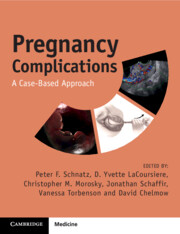Book contents
- Pregnancy Complications
- Pregnancy Complications
- Copyright page
- Contents
- Contributors
- Preface
- Note from the Editor-in-Chief
- Normal Laboratory Values (Conventional Units) []
- Section 1 Antepartum (Early Pregnancy)
- Section 2 Antepartum (Mid-trimester)
- Section 3 Antepartum (Late Pregnancy)
- Section 4 Antepartum (Medical Complications)
- Section 5 Antepartum (Infectious Complications)
- Section 6 Intrapartum/Delivery
- Case 46 A 40-Year-Old at 41 Weeks with a Closed Cervix after 12 Hours of Induction
- Case 47 A 25-Year-Old at 39 Weeks’ Gestation Presents with Regular Contractions and Minimal Cervical Change
- Case 48 A 35-Year-Old at 40 Weeks with Ruptured Membranes and Arrest of Cervical Dilation at 7 cm for 3 Hours
- Case 49 A 30-Year-Old at 36 Weeks’ Gestation with Breech Presentation
- Case 50 A 25-Year-Old at 39 Weeks’ Gestation with Brow Presentation at 9 cm Dilation
- Case 51 A 30-Year-Old at 39 Weeks’ Gestation with Fever in Labor
- Case 52 A 20-Year-Old at 39 Weeks’ Gestation with Persistent Occiput Posterior Presentation, Arrest of Descent, and Worsening Fetal Heart Rate Tracing
- Case 53 A 25-Year-Old at 40 Weeks’ Gestation with a Cesarean Delivery after a Failed Vacuum
- Case 54 A 25-Year-Old at 40 Weeks’ Gestation with Broad Ligament Extension during Cesarean Delivery
- Case 55 A 25-Year-Old at 40 Weeks’ Gestation with Urine Noted in Operative Field during Repeat Cesarean
- Case 56 A 20-Year-Old with a Fourth-Degree Perineal Laceration
- Case 57 A 25-Year-Old at 39 Weeks’ Gestation with Abdominal Pain, Vaginal Bleeding, and Worsening Fetal Heart Rate Tracing during TOLAC
- Case 58 A 40-Year-Old at 39 Weeks’ Gestation Becomes Unresponsive during the Second Stage of Labor
- Case 59 A 45-Year-Old at 39 Weeks’ Gestation Presents in Ventricular Fibrillation Undergoing CPR
- Case 60 A 35-Year-Old with a Vaginal Mass and Hemorrhage Immediately after Delivery
- Case 61 A 30-Year-Old with an Undelivered Placenta 30 Minutes Following Delivery
- Case 62 A 30-Year-Old at 38 Weeks’ Gestation with “Turtle Sign” Noted at Delivery
- Section 7 Postpartum
- Section 8 Fetal Complications
- Section 9 Placental Complications
- Section 10 Complications of the Cord, Amnion, and Gravid Uterus
- Section 11 Psychosocial Considerations
- Index
- References
Case 46 - A 40-Year-Old at 41 Weeks with a Closed Cervix after 12 Hours of Induction
from Section 6 - Intrapartum/Delivery
Published online by Cambridge University Press: 08 April 2025
- Pregnancy Complications
- Pregnancy Complications
- Copyright page
- Contents
- Contributors
- Preface
- Note from the Editor-in-Chief
- Normal Laboratory Values (Conventional Units) []
- Section 1 Antepartum (Early Pregnancy)
- Section 2 Antepartum (Mid-trimester)
- Section 3 Antepartum (Late Pregnancy)
- Section 4 Antepartum (Medical Complications)
- Section 5 Antepartum (Infectious Complications)
- Section 6 Intrapartum/Delivery
- Case 46 A 40-Year-Old at 41 Weeks with a Closed Cervix after 12 Hours of Induction
- Case 47 A 25-Year-Old at 39 Weeks’ Gestation Presents with Regular Contractions and Minimal Cervical Change
- Case 48 A 35-Year-Old at 40 Weeks with Ruptured Membranes and Arrest of Cervical Dilation at 7 cm for 3 Hours
- Case 49 A 30-Year-Old at 36 Weeks’ Gestation with Breech Presentation
- Case 50 A 25-Year-Old at 39 Weeks’ Gestation with Brow Presentation at 9 cm Dilation
- Case 51 A 30-Year-Old at 39 Weeks’ Gestation with Fever in Labor
- Case 52 A 20-Year-Old at 39 Weeks’ Gestation with Persistent Occiput Posterior Presentation, Arrest of Descent, and Worsening Fetal Heart Rate Tracing
- Case 53 A 25-Year-Old at 40 Weeks’ Gestation with a Cesarean Delivery after a Failed Vacuum
- Case 54 A 25-Year-Old at 40 Weeks’ Gestation with Broad Ligament Extension during Cesarean Delivery
- Case 55 A 25-Year-Old at 40 Weeks’ Gestation with Urine Noted in Operative Field during Repeat Cesarean
- Case 56 A 20-Year-Old with a Fourth-Degree Perineal Laceration
- Case 57 A 25-Year-Old at 39 Weeks’ Gestation with Abdominal Pain, Vaginal Bleeding, and Worsening Fetal Heart Rate Tracing during TOLAC
- Case 58 A 40-Year-Old at 39 Weeks’ Gestation Becomes Unresponsive during the Second Stage of Labor
- Case 59 A 45-Year-Old at 39 Weeks’ Gestation Presents in Ventricular Fibrillation Undergoing CPR
- Case 60 A 35-Year-Old with a Vaginal Mass and Hemorrhage Immediately after Delivery
- Case 61 A 30-Year-Old with an Undelivered Placenta 30 Minutes Following Delivery
- Case 62 A 30-Year-Old at 38 Weeks’ Gestation with “Turtle Sign” Noted at Delivery
- Section 7 Postpartum
- Section 8 Fetal Complications
- Section 9 Placental Complications
- Section 10 Complications of the Cord, Amnion, and Gravid Uterus
- Section 11 Psychosocial Considerations
- Index
- References
Summary
Labor induction is common and frequently recommended based on maternal or fetal indications. It may also be chosen by a patient with a term pregnancy after 39 weeks’ gestation. When compared with expectant management, labor induction at term is associated with a reduced risk of cesarean delivery (CD) and the associated maternal and neonatal morbidities in current and subsequent pregnancies. In patients with unfavorable cervices undergoing induction, cervical ripening should be performed prior to administration of oxytocin to reduce the risk of CD and decrease time to delivery. Expected durations of the latent phase of spontaneous labor cannot be applied to induced labor. There are not widely accepted criteria for the diagnosis of a prolonged latent phase of induced labor, or a “failed induction.” The metrics described to diagnose arrest of dilation in the active phase of labor should also not be applied to the latent phase. Cesarean delivery can be avoided by requiring membrane rupture and oxytocin administration for at least 12–18 hours prior to diagnosing a failed induction for nonprogression to the active phase. Consideration should be given to allowing 24 hours or more of induction to enter the active phase if maternal and fetal statuses permit.
Keywords
- Type
- Chapter
- Information
- Pregnancy ComplicationsA Case-Based Approach, pp. 141 - 142Publisher: Cambridge University PressPrint publication year: 2025

